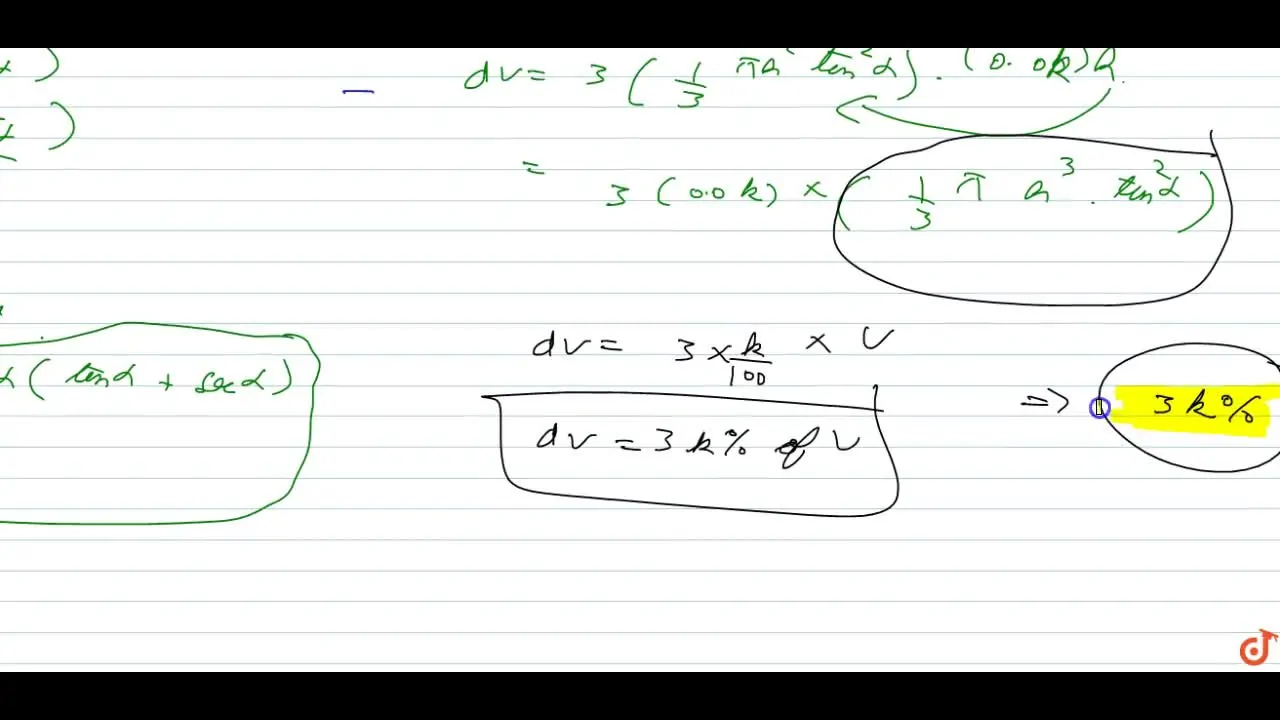The height of a cone increases by k% its semi-vertical angle remaining the same. What is the approximate percentage increase (i) in total surface area, and (ii) in the volume, assuming that k is small?
Therefore,
Δhh=Δrr=Δll
Also, Δhh×100=k
Then, Δhh×100=Δrr×100=Δll×100=k..(1)
(i) Total surface area of the cone, T=πrl+πr2
Differentiating both sides w, r, t, r, we get
dTdr=πl+πrdldr+2πr
⇒dTdr=πl+πrlr+2πr[{From}(1),dldr=ΔlΔr=lr]
⇒dTdr=πl+πl+2πr
⇒dTdr=2π(l+r)
Therefore, ΔT=dTdrΔr=2π(l+r)×kr100=2krπ(l+r)100
Therefore, ΔTT×100=(2kra(l+r)100)2πr(l+r)×100=2k%
Hence, the percentage increase in total surface area of cone is 2k.%
(ii) Volume of cone, V=13πr2h
Differentiating both sides w. r. t. h, we get
dVdh=13πr2+13πh2rdrdh
⇒dVdh=13πr2+13πh2rrh[{From}(1),drdh=ΔrΔh=rh]
⇒dVdh=13πr2+23πr2
⇒dVdh=πr2
Therefore,
ΔV=dVdhdh=πr2×kh100=kπr2h100
Therefore, ΔVV×100=(kπr2h100)13πr2h×100=3k2
Hence, the parcentage increase in thevolume of thecone is 3k.%
Related Playlists
Similar Questions
The height of a cone increases by 2%, its semi-vertical angle remaining the same. What is the approximate percentage increase (i) in total surface arca, (ii) in the volume.
View SolutionA solid cube is cut into 27 identical cubes. What is the percentage increase in the total surface area?
View SolutionThe volume of a spherical balloon is increased by 700%. What is the percentage increase in its surface area ?
View SolutionThe radius of a sphere is doubled. The percentage of increase in its surface area is
View SolutionIf the height of a cone is increased by 100% then its volume is increased by :
View SolutionIf each edge of a cube is increased by 50%, the percentage increase in its surface area is
View SolutionIf each edge of a cube is increased by 40%, the percentage increase in its surface area is
View SolutionIf the radius of the base and the height of a right circular cone are increased by 20%, then what is the approximate percentage increase in volume ?
View SolutionIf the height of cylinder is increased by 35% and radius is increased by 10%, then what will be the percentage increase in curved surface area of cylinder?
View SolutionIf each edge of a cube is increased by 50%, find the percentage increase in its surface area.
View Solution


